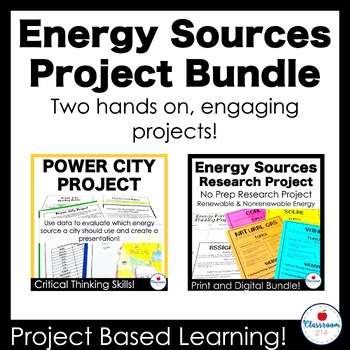Renewable and Nonrenewable Energy Sources Project Bundle
- Zip

What educators are saying
Products in this Bundle (2)
Bonus
Description
Two dynamic renewable and nonrenewable energy sources projects. Student will apply research skills to learn about renewable and nonrenewable energy sources and then apply their knowledge to help a fictional community decide which two energy sources are best for their town.
These projects put students in charge of their learning and keep them motivated with real life scenarios while improving their critical thinking, persuasive writing, and public speaking skills, and research skills. Minimal prep needed for both activities.
WHAT'S INCLUDED
1. Renewable and Nonrenewable Resources Research Project - Working in small groups or individually students research one energy source and create a presentation to teach their classmates.
- Includes links to high quality resources for research
- Print and digital version included
- Work individually or in small groups
2. Power City Project - Using the provided data sources students evaluate the best energy options for a fictional city and create a persuasive presentation to show why their two energy choices are best.
- Data based decision making (students use tables, maps, newspaper articles, and other data sources for information)
- Highly engaging
- Work individually or in small groups
3. Activity Participation Grade Sheet as a bonus file.
- You'll use this handy resource over and over again to provide quick and clear feedback to students and improve their focus during classroom activities.
Created by Classroom 214
Follow my store to hear about new products and sales. New resources are 50% off for the first 24 hours.





